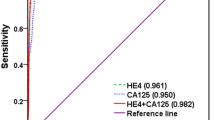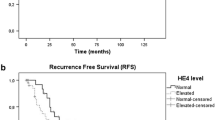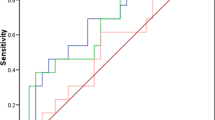Abstract
Background
This study was designed to determine whether serum HE4 is an independent prognostic factor in ovarian cancer patients.
Methods
We measured HE4 in pretreatment serum samples from 80 women with epithelial ovarian cancer, using an enzyme-linked immunosorbent assay. The results were correlated with clinical data.
Results
The median serum HE4 level in ovarian cancer patients was 98.7 (range, 80.3–222.8) pg/ml. Elevated serum HE4 levels before therapy significantly correlated with a poorer progression free survival (log-rank test, P = 0.017). Multivariate analysis revealed serum HE4 to be an independent prognostic factor for progression-free survival (P = 0.036). In multivariate regression analysis, high serum HE4 levels significantly correlated with high tumor grade and serous histology (P = 0.004 and 0.017). In addition, high serum HE4 levels were significantly associated with residual tumor size and operative time (P = 0.003 and 0.033).
Conclusions
Pretreatment serum HE4 seems to be an additional factor for predicting the outcome of patients with epithelial ovarian cancer. Due to its independence from established prognostic factors, serum HE4 may provide additional prognostic information.


Similar content being viewed by others
References
Jemal A, Murray T, Ward E, et al. Cancer statistics, 2005. CA Cancer J Clin. 2005;55(1):10–30.
Park B, Park S, Kim TJ, et al. Epidemiological characteristics of ovarian cancer in Korea. J Gynecol Oncol. 2010;21(4):241–7.
Bast RC Jr., Badgwell D, Lu Z, et al. New tumor markers: CA125 and beyond. Int J Gynecol Cancer. 2005;15(Suppl 3):274–81.
Bouchard D, Morisset D, Bourbonnais Y, Tremblay GM. Proteins with whey-acidic-protein motifs and cancer. Lancet Oncol. 2006;7(2):167–74.
Bingle L, Singleton V, Bingle CD. The putative ovarian tumour marker gene HE4 (WFDC2), is expressed in normal tissues and undergoes complex alternative splicing to yield multiple protein isoforms. Oncogene. 2002;21(17):2768–73.
Berry NB, Cho YM, Harrington MA, et al. Transcriptional targeting in ovarian cancer cells using the human epididymis protein 4 promoter. Gynecol Oncol. 2004;92(3):896–904.
Drapkin R, von Horsten HH, Lin Y, et al. Human epididymis protein 4 (HE4) is a secreted glycoprotein that is overexpressed by serous and endometrioid ovarian carcinomas. Cancer Res. 2005;65(6):2162–9.
Hellstrom I, Raycraft J, Hayden-Ledbetter M, et al. The HE4 (WFDC2) protein is a biomarker for ovarian carcinoma. Cancer Res. 2003;63(13):3695–700.
Rosen DG, Wang L, Atkinson JN, et al. Potential markers that complement expression of CA125 in epithelial ovarian cancer. Gynecol Oncol. 2005;99(2):267–77.
Bingle L, Cross SS, High AS, et al. WFDC2 (HE4): a potential role in the innate immunity of the oral cavity and respiratory tract and the development of adenocarcinomas of the lung. Respir Res. 2006;7:61.
Moore RG, Brown AK, Miller MC, et al. The use of multiple novel tumor biomarkers for the detection of ovarian carcinoma in patients with a pelvic mass. Gynecol Oncol. 2008;108(2):402–8.
Moore RG, McMeekin DS, Brown AK, et al. A novel multiple marker bioassay utilizing HE4 and CA125 for the prediction of ovarian cancer in patients with a pelvic mass. Gynecol Oncol. 2009;112(1):40–6.
Huhtinen K, Suvitie P, Hiissa J, et al. Serum HE4 concentration differentiates malignant ovarian tumours from ovarian endometriotic cysts. Br J Cancer. 2009;100(8):1315–9.
Hellstrom I, Hellstrom KE. SMRP and HE4 as biomarkers for ovarian carcinoma when used alone and in combination with CA125 and/or each other. Adv Exp Med Biol. 2008;622:15–21.
Havrilesky LJ, Whitehead CM, Rubatt JM, et al. Evaluation of biomarker panels for early stage ovarian cancer detection and monitoring for disease recurrence. Gynecol Oncol. 2008;110(3):374–82.
Lowe KA, Shah C, Wallace E, et al. Effects of personal characteristics on serum CA125, mesothelin, and HE4 levels in healthy postmenopausal women at high-risk for ovarian cancer. Cancer Epidemiol Biomarkers Prev. 2008;17(9):2480–7.
Scholler N, Crawford M, Sato A, et al. Bead-based ELISA for validation of ovarian cancer early detection markers. Clin Cancer Res. 2006;12(7 Pt 1):2117–24.
Royston P. Multiple imputation of missing values. STATA J. 2004;4:227–41.
Harrell FE Jr., Lee KL, Mark DB. Multivariable prognostic models: issues in developing models, evaluating assumptions and adequacy, and measuring and reducing errors. Stat Med. 1996;15(4):361–87.
Kobel M, Kalloger SE, Boyd N, et al. Ovarian carcinoma subtypes are different diseases: implications for biomarker studies. PLoS Med. 2008;5(12):e232.
Kamei M, Yamashita S, Tokuishi K, et al. HE4 expression can be associated with lymph node metastases and disease-free survival in breast cancer. Anticancer Res. 2010;30(11):4779–83.
Acknowledgment
This study was funded by the grant of the National Cancer Center, Korea (Grant No. 0910260-3). We thank Ms. Il Ji Jeon for her technical support.
Conflicts of Interest
The authors declare that there are no conflicts of interest.
Author information
Authors and Affiliations
Corresponding author
Rights and permissions
About this article
Cite this article
Kong, SY., Han, M.H., Yoo, HJ. et al. Serum HE4 Level is an Independent Prognostic Factor in Epithelial Ovarian Cancer. Ann Surg Oncol 19, 1707–1712 (2012). https://doi.org/10.1245/s10434-011-1943-5
Received:
Published:
Issue Date:
DOI: https://doi.org/10.1245/s10434-011-1943-5




